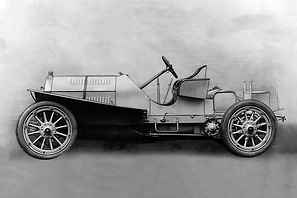After the less than spectacular results of its racing debut at the 1906 Targa Florio, the 60 PS racing car formed the basis for further racing successes for the Benz team. It was equipped with a new engine which, after a reduction in displacement to just under 8 litres, corresponded to the so-called Kaiserpreis formula. The Kaiserpreis, which was announced in 1906 for an international race in June 1907, was intended to promote touring car racing, a goal which was pursued through corresponding regulations. The maximum displacement was 8 litres, the wheelbase was set at a minimum of 3 metres and the distance from the firewall to the centre of the rear axle had to be at least 2 metres. The minimum weight was set at 1175 kilograms. In terms of dimensions and weight, the Targa Florio racing car complied with the Kaiserpreis regulations not without good reason, and so only the engine had to be brought below the 8 litre capacity limit.
Fritz Erle, head of the testing and racing department at Benz & Cie, experimented with two differently specified four-cylinder engines: a short-stroke engine with a bore of 145 mm and a stroke of 120 mm, corresponding to 7926 cc, and a version with a bore/stroke ratio of 140 x 129.5 mm and a displacement of 7974 cc. The debut of the further developed 60 PS racing cars took place in June 1907, less than two months after the Targa Florio, at the Kaiserpreis Race, which was held over a distance of 117 kilometres in the Taunus range. However, neither option was successful: Paul Spamann and Clemens von Bojano had to retire with defects in the two qualifying races; the third Benz, with Victor Hémery at the wheel, was forced to retire after the second lap of the deciding race. Victory in the Kaiserpreis Race went to the Italian Felice Nazzaro in a FIAT.
The Frenchman Hémery, who had been a tremendous addition to the Benz racing team since 1907, had learnt his design engineering trade from Léon Bollée and celebrated great success with Darracq as head of the testing department and racing driver. Hémery was undoubtedly one of the best-known and most renowned active participants of his era. Even his hapless racing debut in the Benz team could not change that. He had more success in September 1907 at the Coppa Florio – a competition organised by Targa Florio founder Vincenzo Florio, which was held on a 60-kilometre circuit with a start and finish in Brescia. After six laps, Hémery was in second place behind Fernando Minoia in an Isotta-Fraschini. Hémery's compatriot and team-mate René Hanriot followed in third place, with Fritz Erle in tenth. With this team performance, Benz & Cie. won the regularity prize, as it had done in the Targa Florio.
The Benz 60 PS racing car achieved further successes in 1907: Also in September, Hémery took second place in the class of the Kaiserpreis racing cars at the prestigious Semmering Hill Climb and at the hill climb in Chateau-Thierry, and a month later he even won his class at the Gaillon Hill Climb – a success he repeated at the Coupe d'Evreux at the beginning of November.


